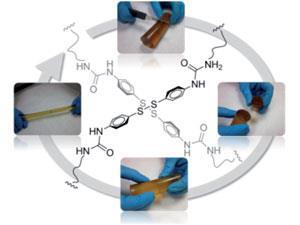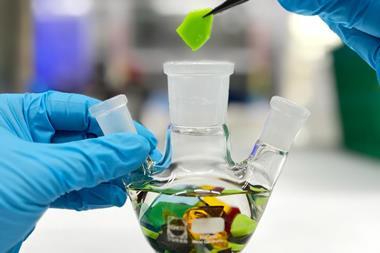Elastomers heal themselves independently thanks to metathesis reaction between aromatic disulphides

Scientists report the first self-healing thermoset elastomer that requires no intervention to induce its repair.
Self-healing polymers mend themselves by reforming broken cross-linking bonds. However, the cross-linking healing mechanism usually requires an external stimulus.
Triggers to promote bond repair include energy inputs, such as heat or light, or specific environmental conditions, such as pH. Self-healing polymers that can spontaneously achieve quantitative healing in the absence of a catalyst have never been reported before, until now.
Ibon Odriozola previously came close when his group at the CIDETEC Centre for Electrochemical Technologies in Spain developed self-healing silicone elastomers using silver nanoparticles as cross-linkers. Unfortunately, an applied external pressure was required and the expensive silver component disfavoured commercialisation. But now they have achieved their goal to prepare self-healing elastomers from common polymeric starting materials using a simple and inexpensive approach.
An industrially familiar, permanently cross-linked poly(urea–urethane) elastomeric network was demonstrated to completely mend itself after being cut in two by a razor blade. It is the metathesis reaction of aromatic disulphides, which naturally exchange at room temperature, that causes regeneration.
Ibon stresses the use of commercially available materials is important for industrial applications. He says the polymer behaves as if it was alive, always healing itself and has dubbed it a “terminator” polymer – a tribute to the shape-shifting, molten T-1000 terminator robot from the Terminator 2 film. It acts as a velcro-like sealant or adhesive, displaying an impressive 97% healing efficiency in just two hours and does not break when stretched manually.
David Mecerreyes, a polymer chemistry specialist at the University of the Basque Country in Spain, sees opportunities to use this elastomer to improve the security and duration of many plastic parts, for example in cars, houses, electrical components and biomaterials.
‘The introduction of a room temperature exchangeable covalent bond in classic thermoset elastomers provides unique autonomous self-healing abilities without comprising the pristine material properties,’ says Richard Hoogenboom, head of the Supramolecular Chemistry group at Ghent University in Belgium. ‘Close resemblance of this novel self-healing thermoset elastomer with current commercial materials makes it highly interesting for extending the lifetime of such materials.’
Future work by the group will concentrate on stronger polymeric materials as the current poly(urea–urethane) composite is relatively soft.












No comments yet